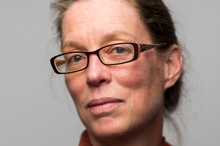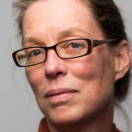

Julia K. Parrish is being honored as a Champion of Change for her dedication to increasing public engagement in science and science literacy.
In 1991, the freighter Tuo Hai collided with the Tenyo Maru, a fishing vessel plying the cold, rich waters just off the southern coast of Vancouver Island, British Columbia. The ensuing oil spill smeared down the pristine outer coast of Washington State, coating beaches in Olympic National Park as well as lands belonging to the Makah, Quileute, Quinault, and Hoh Tribal Nations. At the time, I was a “fledgling scientist” who happened to be working on Tatoosh Island, a rocky outcrop standing sentinel to the Strait of Juan de Fuca, entry point to Seattle and Vancouver, Puget Sound and the Salish Sea. It was a warm, foggy day, and the sea was calm. I stood on the rocks, listening to the sound of wings slapping water as oil-soaked birds literally rowed to shore. Their fate was sealed—and in a very different way, mine was too.
When a disaster happens in our coastal waters, how do we measure its impact? How do we know what is normal, what is right? And more to the point, how do we prove it? In the world of professional science, we will never have enough people, time, or dollars to get the job done – to completely know every part of the natural world, or how healthy, or broken, our ecosystems are. The world is too large, and we are too few. Simply put, scientists need help.
The Coastal Observation and Seabird Survey Team (COASST) was born out of the Tenyo Maru oil spill, out of the realization that scientists alone can’t begin to document what’s normal, let alone how fast things are changing. We need a willing army to make that happen. In short, we need citizens – the locals who watch, and know, and love their backyards, their environment.
In COASST, hundreds of citizens, from California to Alaska, work together with university and agency scientists to document coastal ocean health. And we do that by monitoring the number and type of birds washing up on the tide. Yup. Dead birds. What’s more, COASSTers collect evidence on every bird they find – what kind of foot; precise measurements of the beak, wing, and leg; carefully arranged photographs – allowing them, and independent experts, to use scientific deduction to correctly identify each bird to species. COASSTers get it right 85% of the time – and we can prove it. That makes COASST data immediately usable in science and resource management, and in a court of law.
Does COASST make a difference? Working with oceanographers and marine biologists, our volunteers documented the largest die-off of seabirds (over 8,000) due to a harmful algal bloom anywhere in the world, ever. That information assisted the Washington Wildlife Commission in setting duck hunting limits for bloom-affected species. Our data have also established critical baselines for other sources of mortality, from oil spills to changing climate.
And here’s the thing – if almost a thousand people are willing to survey their coastline for beachcast birds every month, some of them driving and hiking for hours to get there, all of them relegated to the weather the weekend throws at them, just imagine how many thousands of people we could engage in, let’s just say, slightly less smelly pursuits.
They may be geeky, but that’s not to say COASSTers aren’t a social bunch. Nancy Karle recruited her mother Barbara Collins. Tom Hertzig recruited his wife, Connie. Sarah Swanson and Max Smith got married on their COASST beach. Issa Parker brings along her grandson Cedar Parker Pavitt. Gary and Lauren Lester take their Labrador retriever Enzo out to help survey. For his retirement party, Rainer Wieland invited his family and friends to his monthly COASST survey. COASST is about science, and about community. It’s about learning the natural history – the comings and goings, the seasons, the patterns, the species, the power of natural forces. It’s about documenting rightness, and wrongness, beyond a shadow of a doubt. And it’s about sharing that knowledge – with scientists, with community members, and with decision-makers.
In the last century, science was locked up in the ivory tower, practiced by university professors with PhDs who spoke a language that was important, if difficult for most people to understand. It’s no wonder students turned away from science and math. But science matters. Science can unlock how the world works, and can help solve the problems we face. In this century, citizens are getting back into the game. Not as scientists, but as an integral, and essential, part of the science team: the eyes and ears, the data collectors, the natural historians, and the witnesses of how the world is changing. Citizens and scientists working together is a powerful combination, deep in knowledge, broad in reach, and fiercely committed to the stewardship of the places they know and love. COASST is not a single person; it’s a village of dedicated staff (5), amazing undergraduate interns (12), and legions of coastal community members (850!!).
I’m proud to be a Champion of Change. It’s an honor I share with everyone in COASST, because I didn’t do it, we did.
Julia Parish is the Associate Dean of the College of the Environment at the University of Washington.


